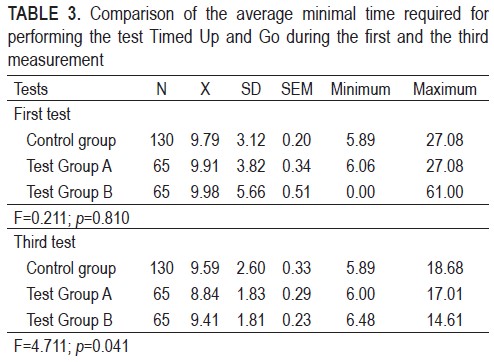Assessment of functional mobility of persons in the 3rd age of life after programmed therapeutic exercises
DOI:
https://doi.org/10.17532/jhsci.2021.1151Keywords:
Third age of life, functional mobility, therapeutic exercisesAbstract
Introduction: Active aging is a process of optimizing of opportunities for health, participation, and safety to improve the quality of life as people age. Therapeutic exercises to strengthen muscles are especially important for the elderly, and the results of such exercises are positive in people with functional limitations. The aim of the study was to assess functional mobility of people in the 3rd age of life after programmed therapeutic exercises.
Methods: The prospective study included two groups of 130 respondents over the age of 65 who came to the “Centre for Healthy Aging” in Novo Sarajevo in the period from September 1, 2014, until March 1, 2015. Using the time up and go test (TUG), the basic functional mobility was assessed and it represents the minimum time the respondent needs to get up from the armchair, walk a distance of three meters, turn around, and sit back in the armchair. We tested the respondents at the beginning, in the middle, and at the end of the study, which lasted for 6 months.
Results: Analysis of the gender structure of the control and the test groups, using the Chi-square test, found a statistically significant difference, and in the test group, there were more female subjects than in the control group, χ2 = 50.620; p = 0.001. Analysis of the functional mobility of the respondents of the test groups using the TUG at the end of the study found that the respondents of the test group needed statistically significantly less time to perform the test (8.84 seconds) compared to the control group (9.59 seconds) and test Group B (9.41 seconds), F = 4.711; p = 0.041.
Conclusion: Programmed therapeutic exercise leads to a significant improvement in functional mobility of persons in the 3rd age of life.
Downloads

Downloads
Published
License
Copyright (c) 2021 Bakir Katana, Eldad Kaljić, Amra Mačak Hadžiomerović, Amila Jaganjac, Samir Bojičić, Namik Trtak

This work is licensed under a Creative Commons Attribution 4.0 International License.










